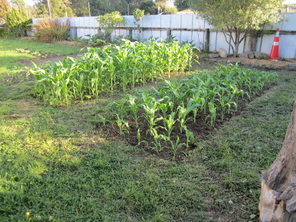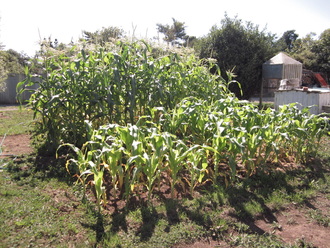
When I started doing this, I hadn't given any thought to planting by the
moon, so it wasn't until later that I realised how the planting of these beds
fell into that. The middle bed was sown first, on Dec 23rd, with 65 seeds.
Turned out this was a good time, according to the moon calendar. The far bed was
sown on Dec 29th with 65 seeds, a bad time according to the calendar. The
closest bed was sown on 8th Jan with our remaining 70 seeds, again a bad time.

The second bed had a 100% germination rate, but I quickly lost a few plants to snails or similar. The results in the 3rd bed were much the same. The plants in these two beds simply weren't as strong as in the first bed, and much more inclined to fall over or die just because.

The proof will be in the harvest, details of which I will add to this page when they are available, sometime soon.
- Corn is mostly wind pollinated, which is the reason it should always be planted in blocks, so you get better pollination. The flowers are long thin stems at the top of the plant loaded with pollen. The pollen must drift down onto the tassels of the potential corn lower on the stems. Planting in blocks also gives these tall plants better stability so they are less likely to get blown over in the wind.
- Each thread in a tassel leads to what could become one kernel of corn. Each thread that is pollinated will cause a kernel to form. Each that is not, will leave an unformed kernel. When you peel open a cob of corn, and find the top part of the cob empty or unformed, this is because not all the threads were pollinated. Gentle shaking the plant, or picking a pollen stem and wiping it over the tassels can aid pollination.
- Corn needs deep, well dug soil to enable it to put down strong roots to support the plant. Roots will show near the soil surface - drawing soil up over them can also help support the plant.
- Beans or peas can be planted under the corn - this will add extra nitrogen which they need lots of. Another popular plant to grow under the corn is watermelon.
- F1 hybrids will not produce true-to-type seeds, so are not worth saving for seeds. Next season I plan to buy heirloom non-hybrid seed.
- All corn seed imported into NZ is required by law to be treated with fungicide - this is the pink coating you see on the seeds. This stuff is systemic - it is all through the plants and cobs. I didn't know much about this when I planted these, but now I do, I won't be planting such treated seeds in the future.
- Corn is also one of the most commonly genetically modified crops. GMOs are super bad for us. For one of the best sources of info on this, watch Genetic Roulette.
Middle bed (planted at the right time in the moon calendar): 14.178 kg
Bed 2 (planted at the wrong time): 4.22 kg
Bed 3 (planted at the wrong time) 4.112 kg
So the middle bed yielded more than 3 times as much sweetcorn, even though the total number of plants was the same or less than the other beds!
I also noticed that the pollination was better in the middle bed - the other two beds had a lot more cobs with missing kernels or entire ends that were unpollinated (even though I helped all three beds along by shaking plants and/or wiping silks with strands of pollen).
 RSS Feed
RSS Feed
